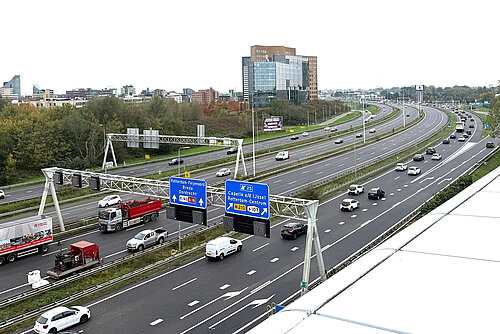800 m of high-precision work on the A16 in the Netherlands
Rotterdam, the Netherlands. Over 800 m of single-seal expansion joints on the A16 motorway in the Rotterdam region are currently being replaced as part of a major renovation project. The dedicated team at MAURER Netherlands is managing to replace up to 100 m in a single weekend.
The A16 is a busy axis for international transit between Belgium and the Netherlands, as well as for access to the Port of Rotterdam. The section between Terbregseplein and Ridderkerk is undergoing major maintenance and renovation work, which began in August 2025 and is due to continue until May 2026. This project involves renewing the asphalt, repairing roadsides, bridges and viaducts, and replacing expansion joints.
Expansion joints act like flexible connections between sections of bridge or viaduct and the ends of these structures. They are important components, as they compensate for structural expansions and contractions due to temperature fluctuations, for example, and create an expanding gap that can still be driven over safely by traffic.
As many metres as possible
MAURER Netherlands is responsible for replacing the expansion joints on the A16. There are 46 of these on the 3-km-long section from the Van Brienenoordbrug bridge over the Nieuwe Maas to the ’s-Gravenweg viaduct, a total length of 800 metres of expansion joints. Every replacement requires a full closure of the respective bridge. Branch Manager Jeroen Melief describes the project: “The trick here is to install as many metres of expansion joints as possible on as few weekends as possible, while also making sure that everything fits precisely.”
This requires exact planning in advance. MAURER took the measurements for every single expansion joint on site in April/May 2025, before comparing them with the existing drawings of the bridge cross-sections. After the resulting detailed plans were checked and approved by the client, production of the expansion joints began at Bernsdorf near Dresden.
The existing expansion joints are removed over the course of a single weekend, before the gap is covered with temporary asphalt so that traffic can pass over. On the following weekend, this asphalt is also removed and the new expansion joint is installed.
The section of the A16 being renovated has six lanes in each direction. From a technical perspective, the motorway consists of four parallel structures, each with three lanes. This means that the expansion joints to be replaced always stretch across three lanes and are each around 20 metres long.
Good teamwork ensures a smooth project
In order to reduce the number of closures, up to four consecutive expansion joints are worked on in a single night, sometimes in pairs. The joints on onevthree-lane structure are removed at the same time as the new ones are installed on the parallel structure. This requires precise coordination: “Everything on the construction site goes quiet at that moment”, explains Branch Manager Melief, “even though there are around 20 people on site. We’ve been working well together for many years. Everyone understands their job and knows that success depends on each and every one of us".
The necessary logistics are also highly sophisticated. When work is ongoing on multiple consecutive expansion joints, the vehicles with the necessary materials, tools and machinery must be available everywhere.
60 - 100 m, or three to five expansion joint constructions, can be installed on a single weekend depending on their position. MAURER is producing a total of 580 m of XC1-Reno expansion joints and 280 m of D1-Reno for the project. These are single-seal expansion joints with a movement of 100 and 80 mm respectively. The XC1 also has a noise reduction system on the top surface. Reno expansion joints are specially certified for use in the Netherlands. They have anchoring plates instead of the usual anchoring loops. The plates are drilled, glued and cast with steel fibre-reinforced concrete. “The advantage of this is that there is no need to interfere with the existing concrete. All we have to do is remove the asphalt”, explains Melief. The special steel
fibre-reinforced concrete is delivered in sacks and mixed with water on site to form a mortar that is ready for use.
The renovation of the expansion joints is organised into eight phases running from September 2025 to May 2026. Each of these phases requires a full closure of one main carriageway.


